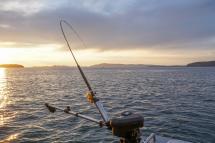ARCHIVED NEWS RELEASE
This document is provided for archival purposes only. Archived documents
do not reflect current WDFW regulations or policy and may contain factual
inaccuracies.
News release July 20, 2022
Contact: Fish Program, 360-902-2700
Public Affairs contact: Mark Yuasa, 360-902-2262

OLYMPIA – Salmon fishing in the San Juan Islands (Marine Area 7) will reopen Thursday, Friday, and Saturday (July 21-23) after Washington Department of Fish and Wildlife (WDFW) fishery managers determined enough Chinook remained in the recreational catch quota.
Catch estimates for the San Juan Islands summer Chinook fishery through July 16 indicate the fishery has reached 44% of the harvest quota (800 of 1,800 fish), 17% of unmarked encounters (690 of 3,991 fish) and 9% of sublegal encounters (230 of 2,573 fish).
“We are really excited to be able to offer more fishing opportunity for anglers in the San Juan Islands this year,” said Kirsten Simonsen, Ph.D., WDFW’s Puget Sound recreational salmon manager. “We know how disappointed anglers were last year with the news of the early July 2021 closure. With that in mind, planning opportunity for the San Juan Islands became a big focus during the annual North of Falcon salmon season setting process.”
During the July 21-23 opener the salmon daily limit is 2, with up to 1 hatchery Chinook. Chinook minimum size is 22”. Other salmon, no minimum size. Release wild Chinook, wild coho, and chum. Additional days may be added based on in-season updates.
The San Juan Islands will reopen for a hatchery coho only fishery – release all Chinook – from Aug. 16 through Sept. 30. The daily limit is 2. No minimum size limit for hatchery-marked coho. Also release chum and wild coho. A Chinook fishery opens within the Bellingham Bay Terminal Area on Aug. 16, see sport fishing regulations for details.
To view the San Juan Islands fishing rules change, visit https://wdfw.wa.gov/fishing/regulations/emergency-rules/marine-area-7-open-additional-days-salmon-fishing-2022-07. Puget Sound salmon seasons are a result of an annual collaborative state and tribal salmon season-setting process known as North of Falcon. To view the Puget Sound salmon fishery guidelines and quotas, visit https://wdfw.wa.gov/fishing/reports/creel/seasonal#ps-summer-chinook.
To support conservation objectives, in areas where multiple salmon stocks overlap—including the San Juan Islands and throughout Puget Sound—state and tribal fisheries managers must abide by harvest quotas and allowable impacts that are federally approved by the National Marine Fisheries Service based on agreed-upon run forecasts prior to the fishing season.
Given this federal oversight and the challenge of accurately assessing individual salmon stocks in a mixed-stock system, WDFW cannot increase salmon harvest quotas or encounter limits while fishing seasons are underway. However, salmon managers can add or extend fishing opportunities when available salmon harvest quota and encounter limits allow, as is the case with this extension.
Several other marine areas are currently open for salmon fishing and can be found on the WDFW website at https://wdfw.wa.gov/fishing/management/north-falcon/summaries. Additional information about this year's sport salmon fisheries and the North of Falcon salmon season setting process can be found at https://wdfw.wa.gov/fishing/management/north-falcon.
WDFW fishery managers continue to call on salmon anglers to submit voluntary Salmon Trip Reports to help to increase the amount of data available for in-season management. These trip reports are just one tool in a suite of options fisheries managers use to collect biological and fishery data for Puget Sound salmon. Other monitoring tools include dockside sampling, test fishing, and boat surveys. Anglers can complete the voluntary Salmon Trip Report Form online at https://str.wdfw-fish.us/home or visit the WDFW website at https://wdfw.wa.gov/licenses/fishing/trip-reporting to download a paper copy.
The Washington Department of Fish and Wildlife works to preserve, protect, and perpetuate fish, wildlife and ecosystems while providing sustainable fish and wildlife recreational and commercial opportunities.